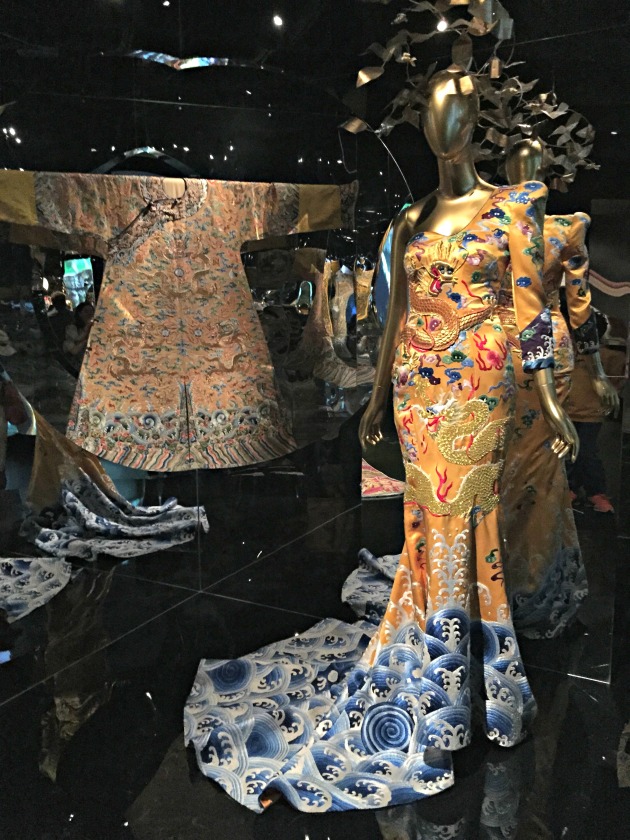One of the biggest perks of my job (besides the major beauty discounts!) is free/reduced admission to most museums throughout New York City! The Lauder family are quite the art aficionados, and Leonard Lauder (aka Estée Lauder’s eldest son) even donated his own private Cubism collection to The Met! This past rainy Saturday my friend Toni and I met for brunch and decided to head to The Met for a little culture (and to stay dry of course!). I have been dying to see the latest exhibition (and theme of The Met Gala this year!) China: Through the Looking Glass and let me tell you I was not disappointed.
This exhibit is described on the website as an exploration of “the impact of Chinese aesthetics on Western fashion and how China has fueled the fashionable imagination for centuries. In this collaboration between The Costume Institute and the Department of Asian Art, high fashion is juxtaposed with Chinese costumes, paintings, porcelains, and other art, including films, to reveal enchanting reflections of Chinese imagery”
The three floor exhibit was incredible and I couldn’t help but take a TON of photos. Every ensemble was truly more beautiful than the last. Each piece was designed by, arguably, the most famous fashion designers in the world, John Galliano, Dior, Chanel, Yves Saint Laurent, and even Andy Warhol! Although my photos definitely do not do this exhibit justice, I thought you might like to take a glimpse into the latest Met exhibit!







 My favorite section of the exhibit was the Blue & White Porcelain room. All the gowns were intricately detailed with the two colors and perfectly coordinated with the porcelain plates on the opposite wall. If only I had an occasion to wear a gown like that…
My favorite section of the exhibit was the Blue & White Porcelain room. All the gowns were intricately detailed with the two colors and perfectly coordinated with the porcelain plates on the opposite wall. If only I had an occasion to wear a gown like that…
While wandering through the China: Through the Looking Glass exhibit I was continually reminded of a play I read during my senior year at Bucknell, M. Butterfly. This is a 1988 play that was loosely based on the relationship between French diplomat Bernard Boursicot and Shi Pei Pu, a male Peking opera singer. M. Butterfly was inspired by Giacomo Puccini’s opera Madama Butterfly.
The play begins with Rene Gallimard a French civil servant serving in the French Embassy in China. While in Beijing, he falls in love with a beautiful Chinese opera singer, Song Liling, who is actually a man masquerading as a woman. During this time, women were banned from performing on stage, so all female roles were played by males. Throughout their romance Song is actually spying on Gallimard for the Peoples Republic of China. This love affair lasts for 20 years, and throughout this time Gallimard is completely unaware or ignorant of the fact that Song Liling is actually a man. Gallimard is tried for treason for betraying his country, which as a result forces him to face the truth about his relationship with Song. At the end of the film, faced with this truth that the woman he has loved for 20 years is actually a man, Gallimard himself takes on the role of the beautiful Butterfly, the woman who died for the sake of an illusory love.
This was a truly fascinating play to read (and to watch on film) for my class and explained the concept of Orientalism clearly. To me, the entire China: Through the Looking Glass exhibit also embodied the concept of Orientalism that I had discussed in my English Lit class.
(The below is an excerpt from a paper that I wrote on the topic last year)
Orientalism refers to “the Indian subcontinent and especially to the Islamic Middle East” (Parker, 278). This is an understanding of the Western discourse regarding the East. Certain stereotypes that the West constructed the East to be were “sensual, lazy, exotic, irrational, cruel, promiscuous, seductive, inscrutable, dishonest, mystical, superstitious, primitive, ruled by emotion” (Parker, 278). This term as a whole focuses on colonial discourse, which produced the idea of the Orient. Said defines “Orientalism as ‘the corporate institution for dealing with the Orient…by making statements about it, authorizing views of it, describing it, teaching it, settling it, ruling over it…a Western style for dominating restructuring, and having authority over the Orient’”(Bryce, 166).
Understanding this concept of Orientalism from class last year made my experience at The Met that much more intriguing. It wasn’t simply beautiful garments, but a representation of the Western interpretation of the Eastern World.
The final aspect of the exhibit that I found fascinating was the film clips that were playing throughout. In the description online the reason for these short clips was to show how “our visions of China are framed by narratives that draw upon popular culture, and also to recognize the importance of cinema as a medium through which to understand the richness of Chinese history.” It was interesting to compare the garments in the film clips to the ones on each wall of the exhibit.
As a whole I was thoroughly impressed with this exhibit. I think that it clearly showed the Western interpretation of China through pop culture, fashion, and art to highlight the fantasy and whimsy of Chinese imagery. I cannot recommend this exhibit enough and encourage you to check it out for yourself if you find time to visit the Big Apple this summer!
Works Cited in the excerpt from my paper
Bryce, Derek. “Repackaging Orientalism.” Tourist Studies 7.2 (2007): 165-91.
Parker, Robert Dale. How to Interpret Literature: Critical Theory for Literary and Cultural Studies. Second ed. Oxford University Press.
